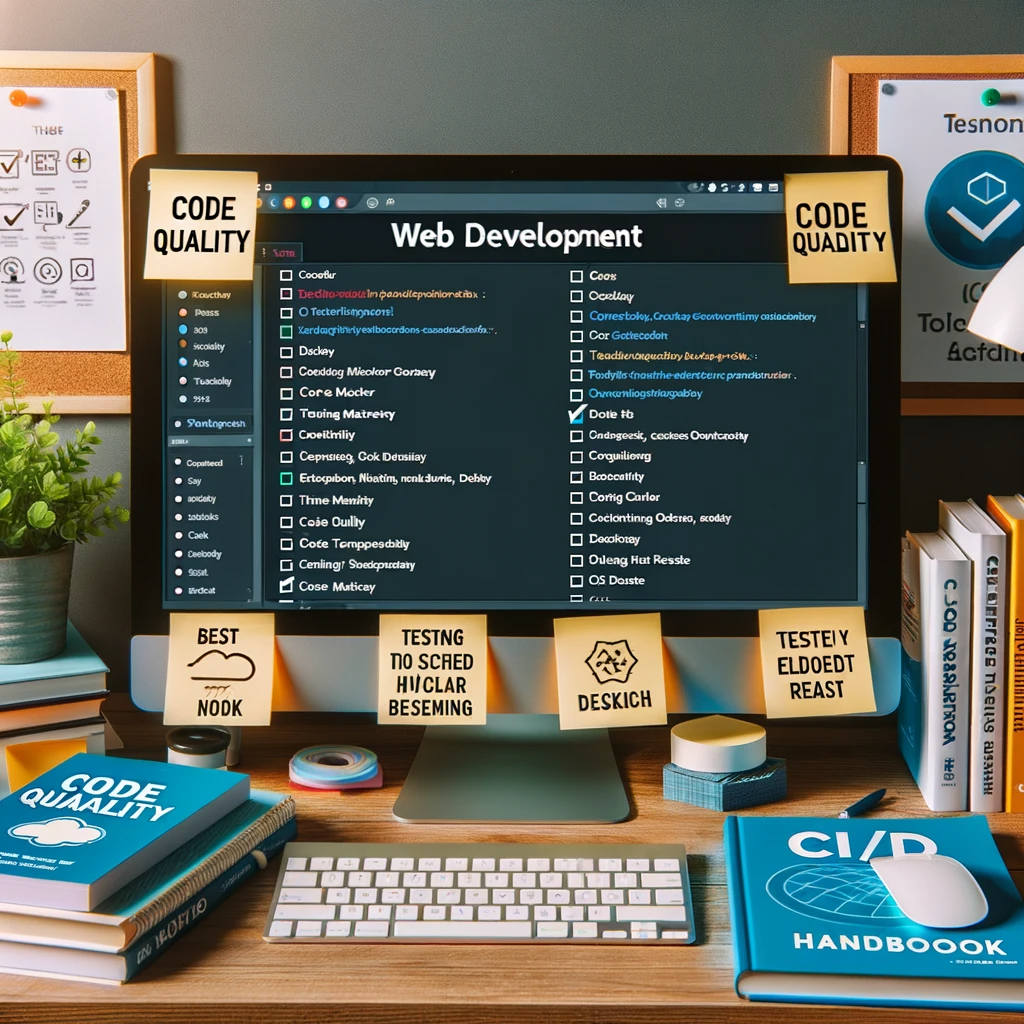Introduction: Web Development
What is Web Development?
Web development is the magic behind every website and web application you visit. It’s the process of creating, designing, and maintaining websites. From your favorite news website to the social media platform you can’t resist scrolling through, web development plays a pivotal role.

Why is Web Development Important?
In today’s digital age, having an online presence isn’t just a luxury; it’s a necessity. Web development provides businesses and individuals the platform to showcase their products, services, and ideas to a global audience. It bridges the gap between a brand and its customers, fostering engagement and driving growth.
Types of Web Development:
Web development can be broadly categorized into three main types:
- Front-end Development (Client-side): This is what users see. It focuses on design, graphics, and user experience.
- Back-end Development (Server-side): This is the backbone of any web application. It’s responsible for managing data, ensuring smooth functionality, and connecting the front-end to the database.
- Full-stack Development: A blend of both front-end and back-end development. Full-stack developers have the skills to handle projects from start to finish.
Who Can Become a Web Developer?
Anyone with a passion for technology and problem-solving! Whether you’re a tech enthusiast looking to dive into coding or someone keen on switching careers, web development is accessible. With countless online resources, courses, and bootcamps, you can start your web development journey from anywhere, at any age.
Front-end Development
What is Front-end Development?
Front-end development, often termed as the “client-side,” is all about the visual aspects of a website—the parts that users interact with directly. It’s the art and science of crafting a seamless user experience, blending aesthetics with functionality.

Front-end Development Languages:
Three pillars support the structure of front-end development:
- HTML (HyperText Markup Language): The skeletal framework of web pages. It defines the structure, like paragraphs, images, and forms.
- CSS (Cascading Style Sheets): The stylist of the web. It determines the look and feel, such as colors, fonts, and layouts.
- JavaScript: The dynamic force. It adds interactivity, animations, and logic to web applications.
Front-end Development Tools:
Tools make the job easier and more efficient. Popular ones include:
- Chrome DevTools: For debugging and optimizing websites.
- Sass: A scripting language that extends CSS, offering more flexibility.
- Webpack: A module bundler and task runner.
Front-end Development Frameworks:
Frameworks provide a predefined structure, speeding up the development process. Heavy hitters in this arena are:
- React: A library for building interactive user interfaces.
- Angular: A framework for creating dynamic web applications.
- Vue.js: A progressive framework for building user interfaces.
Front-end Development Best Practices:
- Responsive Design: Ensure websites look and function well on all device sizes.
- Optimization: Minimize load times by compressing images and using efficient code.
- Accessibility: Design for everyone, keeping in mind users with disabilities.
- Consistent UI: Maintain uniformity in fonts, colors, and design elements
Read More…..
Back-end Development
What is Back-end Development?
Back-end development, also known as “server-side,” is the backbone of a website. While front-end is about what users see, back-end is all about how everything works behind the scenes. It involves databases, servers, and application architecture—the parts that users don’t see but are essential for a site to function.

Back-end Development Languages:
The powerhouses of back-end development are:
- Python: Known for its simplicity and versatility. Frameworks like Django make web development a breeze.
- Java: A robust, object-oriented language popular for its platform independence.
- PHP: A server-side scripting language, especially known for web development.
- Ruby: Dynamic and object-oriented, it’s known for the Ruby on Rails framework.
Back-end Development Frameworks:
These provide structure for building the back-end:
- Django: A high-level Python framework that encourages clean design.
- Ruby on Rails: A framework for Ruby, emphasizing convention over configuration.
- Spring Boot: Java’s response for quick and efficient web applications.
Databases:
Where all the data lives. Popular ones include:
- MySQL: A reliable and efficient relational database.
- MongoDB: A leading noSQL database, perfect for big data and real-time applications.
Servers:
The machinery that hosts our applications. Apache and Nginx are top choices.
Back-end Development Tools:
- Git: Version control to manage and track work.
- Node.js: A runtime environment, letting developers use JavaScript for server-side scripting.
- Docker: A platform used to containerize applications.
Back-end Development Best Practices:
- API Design: Ensure clean and efficient communication between front-end and back-end.
- Security: Implement measures like encryption and regular backups.
- Optimization: Ensure efficient database queries and scalable architecture
Read More….
Full-stack Development
What is Full-stack Development?
Full-stack development is the holistic approach to web development, encompassing both front-end and back-end. A full-stack developer is the jack-of-all-trades in the web world, possessing the skills to build a web application from the ground up, from the user interface to the server logic.

Skills Required for Full-stack Development:
- Languages Mastery: A strong grasp of front-end languages like HTML, CSS, and JavaScript, as well as back-end languages such as Python, Java, or Ruby.
- Database Management: Knowledge of both SQL databases like MySQL and noSQL databases like MongoDB.
- Version Control: Proficiency in using tools like Git to manage codebase changes.
- Server Management: Understanding of server deployment and management using platforms like Apache or Nginx.
Full-stack Development Tools and Frameworks:
- Node.js: Enables JavaScript to be used for back-end development.
- MEAN/MERN Stack: A combination of MongoDB, Express.js, Angular/React, and Node.js.
- Django: Python’s prized framework that covers both front and back ends.
Full-stack Development Best Practices:
- Modular Code: Write reusable and maintainable code.
- Stay Updated: The tech world evolves rapidly. It’s essential to keep up with the latest trends and tools.
- Testing: Regularly test both the front-end and back-end to ensure seamless functionality.
- Security: Implement rigorous security measures, from data validation to encryption
Read More….
Web Design
What is Web Design?
Web design is the art of creating the visual look and feel of a website. It’s about ensuring that websites are not only aesthetically pleasing but also user-friendly and aligned with the brand’s identity. It encompasses everything from layout and color schemes to typography and imagery.

Principles of Web Design:
Great web design isn’t just about beauty; it’s about functionality. Key principles include:
- Balance: Harmonizing light and dark colors to create depth and balance.
- Contrast: Leveraging different sizes, textures, and shapes to guide users.
- Consistency: Maintaining a uniform look and feel across all web pages.
- Unity: Ensuring all parts of the website design relate to one another and function as a whole.
User Experience Design (UX):
UX focuses on the overall feel of the experience. It aims to make users’ interactions as simple and efficient as possible. Aspects include:
- Navigation: Streamlined and intuitive paths for users to follow.
- Interactivity: Engaging elements that promote user interaction.
- Feedback: Immediate responses or actions when users interact.
User Interface Design (UI):
While UX is about the overall feel, UI zeroes in on the specifics of the interface. This encompasses:
- Layout: Organizing content for optimal readability and navigation.
- Visual Elements: Icons, buttons, and sliders that users interact with.
- Typography: Ensuring text is readable, legible, and visually appealing.
Web Design Tools:
There’s an arsenal of tools at a designer’s disposal, including:
- Adobe XD & Photoshop: For design mockups and graphics.
- Sketch: A vector-based design tool.
- Figma: Collaborative design software.
Web Design Best Practices:
- Mobile Responsiveness: Ensuring the design looks good on all devices.
- Fast Load Times: Compressing images and optimizing elements for quick loading.
- Accessibility: Designing for all users, including those with disabilities
Web Performance
What is Web Performance?
Web performance is the measure of how quickly and efficiently a website loads and functions. In an age where users expect near-instantaneous results, optimizing web performance is crucial. A faster site leads to better user engagement, higher conversions, and improved search engine rankings.
Factors that Affect Web Performance:
Several elements can influence a website’s speed and responsiveness:
- Server Response Time: The time taken by the server to respond to a browser request.
- Image and File Sizes: Larger files take longer to load.
- Number of Requests: Every element on a page (images, scripts, stylesheets) requires a separate request, affecting load time.
- Unoptimized Code: Bulky or redundant code can slow down website rendering.
- Browser Caching: Storing frequently used files locally can speed up subsequent visits.
Web Performance Optimization Techniques:
To enhance web performance, consider these strategies:
- Compress Files: Use tools like Gzip to reduce the size of CSS, HTML, and JavaScript files.
- Optimize Images: Use the right format and compress without losing quality.
- Leverage Browser Caching: Store cacheable resources for a longer duration.
- Minimize HTTP Requests: Combine files and streamline elements.
- Use Content Delivery Networks (CDNs): Serve content from servers closest to the user’s location.
Web Performance Testing Tools:
To gauge and improve performance, utilize tools such as:
- Google PageSpeed Insights: Provides recommendations for improvement.
- GTmetrix: Analyzes site speed and optimization.
- Pingdom: Offers website speed testing and performance monitoring
Web Security
What is Web Security?
Web security is the practice of safeguarding websites and web applications against cyber threats. In an interconnected world, the significance of robust web security cannot be overstated. It encompasses measures taken to ensure data protection, maintain website uptime, and instill trust among users.

Common Web Security Threats:
The cyber landscape is rife with challenges. Some prevalent threats include:
- SQL Injection (SQLi): Attackers manipulate a site’s SQL queries to access information.
- Cross-Site Scripting (XSS): Malicious scripts are injected into trusted websites, impacting users.
- Cross-Site Request Forgery (CSRF): Attackers trick users into executing unwanted actions on a web application.
- Distributed Denial of Service (DDoS): Overwhelming traffic is sent to a website, causing it to crash.
Web Security Best Practices:
Building a fortress against cyber threats involves:
- Regular Updates: Keep software, plugins, and systems updated to patch vulnerabilities.
- Secure Passwords: Encourage strong, unique passwords and implement two-factor authentication.
- SSL Certificates: Encrypt data transfers between the server and browser.
- Firewalls: Set up barriers to block malicious traffic and requests.
- Backup Regularly: Ensure data recovery in case of breaches or technical glitches.
Read More….
Web Security Tools:
Equip yourself with tools to fortify defenses:
- Sucuri: A comprehensive security platform for threat detection and attack prevention.
- Cloudflare: Provides a content delivery network with DDoS protection.
- Wordfence: A security plugin for WordPress sites, offering firewall and malware scanning.
Web Accessibility
What is Web Accessibility?
Web accessibility ensures that websites and web applications are usable by everyone, regardless of disabilities. It’s about making the web a more inclusive space, allowing all users to perceive, understand, navigate, and interact with online content effectively.

Web Accessibility Standards:
Several guidelines aim to make the web more accessible:
- WCAG (Web Content Accessibility Guidelines): A comprehensive set of recommendations for creating accessible web content. It covers aspects like text alternatives, adaptable content, and distinguishable elements.
- ARIA (Accessible Rich Internet Applications): A set of attributes that make web content and applications more accessible, especially for dynamic content and advanced user interface controls.
How to Make Your Website Accessible:
To create a more inclusive web experience:
- Keyboard Navigation: Ensure all functionalities are accessible via keyboard.
- Contrast Ratios: Maintain proper contrast between text and background for readability.
- Alt Text: Provide descriptive text for images, aiding screen readers.
- Avoid Auto-Play: Videos or audio that auto-play can be disorienting; always give users control.
- Clear Forms: Label form fields clearly and provide error messages to guide users.
- Flexible Layout: Design a responsive site that works across devices and screen sizes.
Web Hosting
What is Web Hosting?
Web hosting is the service that provides the necessary technologies and services for websites or web applications to be viewed on the internet. Think of it as renting space on a server where your website’s files are stored and delivered to users’ browsers upon request.

Types of Web Hosting:
Different needs call for different hosting solutions:
- Shared Hosting: Multiple websites share one server and its resources. Ideal for beginners and small websites.
- Dedicated Hosting: An entire server is dedicated to a single website. Offers more control and resources.
- Virtual Private Server (VPS) Hosting: A middle-ground between shared and dedicated hosting. Websites share a server, but with allocated resources.
- Cloud Hosting: Resources are spread across multiple servers. It’s scalable and can handle high traffic.
How to Choose a Web Hosting Provider:
Picking the right host is pivotal:
- Uptime: Look for providers guaranteeing at least 99.9% uptime.
- Speed: Faster loading times enhance user experience.
- Customer Support: 24/7 support can be a lifesaver.
- Features: Consider bandwidth, storage, and additional tools.
- Price: Balance between affordability and the quality of service.
Domain Names
What is a Domain Name?
A domain name is the address of your website on the internet. Just as homes have addresses, websites have domain names. It’s what users type into their browser’s address bar to visit your site. For instance, www.example.com is a domain name.

How to Register a Domain Name:
Securing your unique digital address involves a few steps:
- Choose a Name: It should resonate with your brand, be concise, and easy to recall.
- Domain Availability: Use domain checkers to ensure your desired name isn’t taken.
- Domain Registrar: Select a reputable domain registrar to purchase and manage your domain.
- Register: Complete the registration process, which typically involves providing contact information and payment.
DNS Records and Domain Name Management:
The Domain Name System (DNS) translates domain names into IP addresses, making websites accessible. Key components include:
- A Record: Points your domain to an IP address.
- CNAME Record: Redirects one domain to another.
- MX Record: Directs email to your domain’s mail servers.
- TXT Record: Provides text information to sources outside your domain, often for verification purposes.
Managing your domain effectively involves regularly updating DNS records, renewing domain registration, and ensuring domain security.
Content Management Systems (CMS)
What is a Content Management System (CMS)?
A Content Management System (CMS) is software that facilitates creating, editing, organizing, and publishing content on the web. It’s the backbone of many websites today, allowing users to manage content without diving deep into coding.

Popular CMS Platforms:
There’s a myriad of CMS platforms catering to various needs:
- WordPress: Arguably the most popular CMS, it’s user-friendly and offers a vast array of plugins and themes.
- Drupal: Known for its robustness and scalability, it’s ideal for complex sites with heavy content.
- Joomla: A middle ground between WordPress’s ease and Drupal’s power, it provides flexibility in content and structure.
How to Choose the Right CMS for Your Needs:
Finding the perfect CMS match involves considering:
- Ease of Use: A user-friendly interface can make content management a breeze.
- Customization: The availability of themes, plugins, or extensions to tailor your site.
- Security: Prioritize platforms that offer robust security features and frequent updates.
- Scalability: If you foresee your site growing, choose a CMS that can scale with you.
- Community Support: A strong community can be a valuable resource for troubleshooting and advice.
Read More…
Programming Languages
Popular Programming Languages for Web Development:
Programming languages are the building blocks of the digital world.

Here’s a rundown of prominent ones in web development:
- Python: Renowned for its simplicity and versatility, Python is widely used in web development, artificial intelligence, and data analysis.
- Java: An object-oriented language, Java is platform-independent, making it a staple for web and mobile applications.
- PHP: A server-side scripting language, PHP is integral to dynamic websites and is the backbone of WordPress.
- Ruby: Known for its elegance, Ruby and its framework, Ruby on Rails, offer a streamlined web development process.
- JavaScript: A client-side scripting language, JavaScript brings interactivity to websites.
Strengths and Weaknesses of Each Language:
Python:
- Strengths: Intuitive syntax, vast libraries.
- Weaknesses: Slower execution time.
Java:
- Strengths: Platform independence, robust performance.
- Weaknesses: Verbose syntax, memory consumption.
PHP:
- Strengths: Easy integration, strong community support.
- Weaknesses: Not ideal for large applications, security issues.
Ruby:
- Strengths: Readable code, rapid development.
- Weaknesses: Slower runtime, less scalable.
JavaScript:
- Strengths: Universal browser support, asynchronous processing.
- Weaknesses: Inconsistent browser implementation, single-threaded.
How to Choose the Right Programming Language for Your Project:
The choice hinges on project requirements, scalability needs, and the development team’s expertise. For instance, if rapid development is a priority, Ruby might be apt. For extensive projects, Java’s robustness shines.
Web Frameworks
What is a Web Framework?
A web framework is a software framework designed to streamline web application development. It provides a foundation on which software developers can build web apps without starting from scratch, saving time and ensuring best practices.

Popular Web Frameworks:
The digital world boasts an array of frameworks, each with its strengths:
- Django: A high-level Python framework that encourages clean design and offers rapid development.
- Laravel: A PHP framework, Laravel is known for its elegant syntax and robust tools for tasks ranging from authentication to routing.
- Ruby on Rails: Often termed ‘Rails’, this Ruby framework emphasizes convention over configuration, simplifying the coding process.
- Spring Boot: A Java-based framework, Spring Boot is geared towards building production-ready apps with minimal fuss.
- React: Though technically a JavaScript library, React is essential for building user interfaces in web applications.
- Angular: A platform and framework for building single-page client applications using HTML and TypeScript.
How to Choose the Right Web Framework for Your Project:
Selecting a framework revolves around several factors:
- Project Requirements: Does your project need a full-stack framework or just a front-end solution?
- Learning Curve: While some frameworks are beginner-friendly, others may require a steeper learning curve.
- Community Support: A strong community can offer plugins, extensions, and valuable advice.
- Performance Needs: Depending on the expected traffic and required response times, the framework’s efficiency can be pivotal.
Web Development Tools
Popular Web Development Tools:
In the vast domain of web development, tools play a pivotal role in streamlining processes and enhancing productivity.

Here’s a glimpse into the essential ones:
- Code Editors: Software like Visual Studio Code, Atom, and Sublime Text allow developers to write and edit code with features like syntax highlighting and auto-completion.
- IDEs (Integrated Development Environments): Eclipse, IntelliJ IDEA, and NetBeans provide a comprehensive environment with debugging, code completion, and integration capabilities.
- Debugging Tools: Chrome DevTools and Firebug offer insights into how web pages run and help debug issues in real-time.
- Version Control Systems: Git, managed through platforms like GitHub and Bitbucket, lets developers track changes, collaborate, and manage code history.
How to Choose the Right Web Development Tools for Your Needs:
Picking the apt toolset hinges on:
- Project Scale: Larger projects might benefit from robust IDEs, while smaller ones could do with lightweight code editors.
- Collaboration Needs: If teamwork is integral, version control systems become indispensable.
- Language & Framework: Some tools are tailored for specific languages or frameworks.
- Budget: While many tools are open-source and free, premium features might come at a cost.
Read More….
Web Development Best Practices
Code Quality:
Quality is paramount. Adhering to best coding standards ensures your code is readable, maintainable, and efficient. Regularly review and refactor your code to keep it pristine.
Unit Testing:
Testing individual units or components of a software ensures each part functions as intended. Tools like JUnit (for Java) and PyTest (for Python) can be instrumental.
Integration Testing:
This involves testing combined parts of an application to determine if they function together correctly. It’s the next step after unit testing.
Continuous Integration and Continuous Delivery (CI/CD):
CI/CD practices involve automatically building, testing, and deploying applications. Platforms like Jenkins and Travis CI facilitate this seamless integration and deployment process.

Other Web Development Best Practices:
- Responsive Design: Ensure your website looks and functions well on all device sizes.
- Optimization: Minimize CSS, JavaScript, and images for faster load times.
- Semantic HTML: Use HTML elements for their intended purpose for accessibility and SEO benefits.
- Regular Backups: Regularly back up your website to safeguard against data loss.
- Security: Implement HTTPS, utilize security plugins, and regularly update software and plugins.
Conclusion
The Future of Web Development:
Web development is an ever-evolving field, and the horizon holds remarkable innovations:
- Progressive Web Apps (PWAs): These blend the best of web and mobile apps, offering offline capabilities, push notifications, and more.
- Serverless Architectures: This trend involves building and running applications without managing server infrastructure, reducing complexity.
- Single Page Applications (SPAs): SPAs load a single HTML page and dynamically update it, ensuring a smooth user experience.
- Voice Search Optimization: With voice assistants on the rise, optimizing websites for voice search will become imperative.
- Artificial Intelligence & Bots: AI-driven chatbots and support tools will redefine user interactions on websites.
Resources for Learning More About Web Development:
For those eager to dive deeper, here are some resources to explore:
- Online Courses: Platforms like Coursera, Udemy, and edX offer a plethora of courses tailored to various expertise levels.
- Blogs & Websites: Websites like Smashing Magazine, CSS-Tricks, and MDN Web Docs provide invaluable insights and tutorials.
- Books: Titles like “Eloquent JavaScript”, “You Don’t Know JS”, and “Learning Web Design” are must-reads for enthusiasts.
- Community: Engaging with communities on platforms like Stack Overflow and GitHub can be immensely beneficial.
Web Development FAQs
-
What are the most popular web development trends in 2023?
In 2023, the web development landscape is dominated by trends like Progressive Web Apps (PWAs), serverless architectures, AI-driven chatbots, voice search optimization, and Single Page Applications (SPAs). Additionally, the integration of augmented and virtual reality in web experiences is gaining traction.
-
What are the best resources for learning web development?
For those keen on learning web development, online platforms like Coursera, Udemy, and edX are invaluable. Websites like MDN Web Docs, Smashing Magazine, and CSS-Tricks offer in-depth tutorials and articles. Books such as “Eloquent JavaScript” and “You Don’t Know JS” are also recommended.
-
What are the most common mistakes that new web developers make?
New web developers often overlook the importance of responsive design, neglect SEO best practices, ignore web accessibility, and underestimate the significance of performance optimization. Additionally, not keeping up with the latest trends and technologies can be a pitfall.
-
How can I improve my web development skills?
Practice is key. Regularly build projects, contribute to open-source platforms, attend web development workshops, and engage in coding challenges. Joining web developer communities and forums for discussions and feedback can also be beneficial.
-
What are the job prospects for web developers?
The demand for web developers continues to grow with the increasing reliance on web-based applications. Opportunities span across industries, from tech firms and financial institutions to healthcare and e-commerce.
-
What are the different types of web developer jobs?
Web developer roles can be categorized as front-end developers, back-end developers, full-stack developers, and web designers. There are also specialized roles like WordPress developers, e-commerce developers, and UX/UI designers.
-
What are the soft skills that web developers need?
Beyond technical prowess, web developers should possess strong communication skills, problem-solving abilities, creativity, attention to detail, and a collaborative mindset.
-
What are the best ways to find a job as a web developer?
Networking, attending tech meetups, leveraging platforms like LinkedIn, and exploring job boards such as Stack Overflow Jobs, Indeed, and Glassdoor can aid in job hunting. Additionally, having a robust online portfolio can make a difference.
-
What is the average salary for a web developer?
Salaries vary based on location, experience, and expertise. As of 2023, the average salary for a web developer in the US is around $75,000 to $100,000 annually, but this can be higher or lower depending on various factors.
-
What are the future trends in web development?
The future promises innovations like increased use of AI in web design, quantum computing impacting web security, more immersive AR and VR web experiences, and the rise of edge computing in web development.
Table of Contents
Toggle






